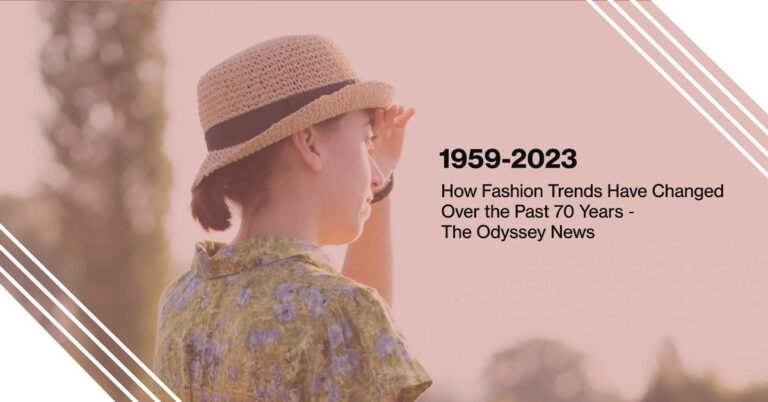Fashion is a dynamic reflection of societal norms, cultural movements, and individual expression, constantly evolving over time. From the glamorous and elegant styles of the 1950s to the revolutionary youth culture of the 1960s and the era of excess in the 1980s, the past 70 years have witnessed a fascinating journey of fashion trends.
Introduction: Setting the Stage for Fashion Evolution
Fashion is like that one friend who constantly changes their mind about what they want to eat for dinner – always evolving, sometimes unpredictable, but undeniably interesting. From poodle skirts to power suits, the last 70 years have seen a whirlwind of fashion trends that mirror the ever-shifting societal dynamics and cultural influences. Let’s take a stylish trip down memory lane and explore how fashion has transformed from the 1950s to 2023.
1950s Fashion: The Golden Age of Glamour and Elegance
The Influence of Hollywood Icons
The 1950s were all about channeling the elegance and sophistication of Hollywood starlets like Audrey Hepburn and Marilyn Monroe. Women’s fashion embraced hourglass silhouettes, emphasizing tiny waists and full skirts that oozed femininity and grace.
Silhouettes and Fabrics of the Decade
Structured silhouettes, defined waistlines, and soft fabrics like chiffon and tulle dominated the fashion scene. Pastel colors, floral prints, and polka dots were go-to choices for dresses, while men favored tailored suits with sharp lines and narrow lapels.
Iconic Fashion Trends of the 1950s
The 1950s introduced iconic trends like the full-circle skirts, capri pants, and twin sets that became wardrobe staples for women. Men embraced the clean-cut look with fedora hats, cuffed trousers, and leather oxford shoes, exuding a timeless charm that still influences modern fashion.
1960s-1970s Fashion: The Revolution of Youth Culture and Bohemian Style
The Youthquake Movement
The swinging sixties and groovy seventies saw a seismic shift in fashion fueled by the youthquake movement. Mini skirts, bold patterns, and vibrant colors took center stage as young people rebelled against the conservative norms of the previous decade.
The Hippie Influence on Fashion
Hippie culture permeated fashion with flowing maxi dresses, fringe details, and psychedelic prints becoming synonymous with the free-spirited lifestyle. Bell-bottom pants, tie-dye shirts, and peace signs became iconic symbols of the era’s counterculture movement.
Key Trends from the 1960s-1970s
From the mod style of the sixties to the bohemian flair of the seventies, key trends included platform shoes, jumpsuits, and peasant blouses that reflected the era’s embrace of individuality and self-expression.
1980s Fashion: The Era of Excess and Power Dressing
Power Suits and Shoulder Pads
The 1980s were all about power dressing, where women adopted structured power suits with exaggerated shoulder pads to exude confidence and authority in the workplace. Men embraced bold colors, oversized blazers, and statement accessories to showcase their status.
Punk and New Wave Influence
Punk rock and new wave music influenced fashion with leather jackets, ripped jeans, and studded accessories becoming edgy staples in wardrobes. Bold makeup, asymmetrical hairstyles, and statement jewelry added a rebellious touch to the glamorous excess of the decade.
Popular Fashion Trends of the 1980s
Neon colors, spandex leggings, and high-tops sneakers dominated the fashion scene in the 1980s, epitomizing the era’s love for all things bold and flashy. Whether you were rocking a perm or sporting a Members Only jacket, the 80s were a time of unapologetic excess and daring style choices.
So, whether you’re a fan of the classic elegance of the 1950s, the bohemian vibes of the 60s and 70s, or the bold excess of the 80s, one thing’s for sure – fashion trends may come and go, but the fun lies in experimenting and finding your own unique style in every era.
1990s Fashion: The Rise of Streetwear and Minimalism
The Emergence of Grunge Fashion
The 1990s witnessed the rise of grunge fashion, characterized by its anti-establishment and rebellious vibe. Think flannel shirts, ripped jeans, and combat boots – the epitome of effortlessly cool style.
The Influence of Hip-Hop Culture
Hip-hop culture heavily influenced 1990s fashion, with baggy pants, oversized hoodies, and bold accessories becoming mainstream. Icons like Tupac Shakur and TLC shaped the style landscape with their unique flair.
Minimalist Aesthetics in 1990s Fashion
Alongside the grunge and hip-hop trends, minimalist fashion also gained popularity in the 1990s. Clean lines, neutral colors, and simple silhouettes dominated runways and street style, reflecting a desire for understated elegance.
2000s-2010s Fashion: The Influence of Technology and Fast Fashion
The Rise of Fast Fashion Brands
The 2000s and 2010s saw the meteoric rise of fast fashion brands like Zara and H&M, offering affordable and trend-driven clothing at a rapid pace. This shift democratized fashion, making current trends accessible to the masses.
Social Media’s Impact on Fashion Trends
With the advent of social media platforms like Instagram and Pinterest, fashion trends spread like wildfire. Influencers and celebrities became influential in shaping style choices, with viral moments dictating what was hot or not.
Sustainability Movements in the Fashion Industry
Amidst fast fashion’s dominance, a parallel movement for sustainability emerged. Consumers and brands began prioritizing eco-friendly practices, leading to a shift towards ethical fashion production and the rise of sustainable materials.
2020s Fashion: Sustainability, Diversity, and Individuality
The Shift towards Sustainable Fashion Practices
In the 2020s, sustainability took center stage in the fashion industry. From upcycling to circular fashion, brands embraced eco-conscious strategies to reduce their environmental impact and meet the demands of an increasingly eco-aware consumer base.
Celebrating Diversity in Fashion
Diversity became a non-negotiable aspect of fashion in the 2020s. Runways and campaigns showcased models of varying races, body types, and gender identities, promoting inclusivity and representation in the industry.
Individuality and Personal Style in the 2020s
Gone are the days of cookie-cutter fashion. The 2020s celebrated individuality, encouraging people to express their unique style preferences. From gender-fluid fashion to DIY customization, personal expression took center stage in shaping trends.
Conclusion: Reflecting on Seven Decades of Fashion Trends
As we journey from the rebellious grunge of the 1990s to the sustainable and inclusive ethos of the 2020s, one thing remains clear – fashion is a reflection of our society’s values, attitudes, and aspirations. Each era leaves a distinct mark on the style landscape, showcasing the ever-evolving nature of this creative industry.
As we conclude this exploration of fashion trends spanning seven decades, it becomes evident that style is not just about clothing—it is a reflection of the zeitgeist, a canvas for societal shifts, and a celebration of individuality. From the elegance of the 1950s to the diversity and sustainability of the 2020s, each era has left its mark on the fashion landscape. As we look towards the future, let us embrace the lessons of the past and continue to evolve, innovate, and express ourselves through the ever-changing tapestry of fashion.
FAQs:
Q: What is the most iconic fashion trend of the past 70 years?
A: The most iconic fashion trend of the past 70 years is subjective and can vary depending on personal preferences. However, some of the most iconic trends include the New Look by Christian Dior in the 1950s, the mini skirt in the 1960s, and power dressing in the 1980s.
Q: How has technology influenced fashion trends?
A: Technology has played a significant role in shaping fashion trends over the years. From the introduction of synthetic fabrics to the rise of fast fashion and social media, technology has made fashion more accessible and inclusive.
Q: What is the impact of social media on fashion?
A: Social media has had a significant impact on fashion, with influencers and street style playing a crucial role in setting trends. It has also made fashion more accessible to a wider audience and has given consumers a platform to voice their opinions and demand transparency from brands.
Q: How has sustainability become a focus in the fashion industry?
A: With the rise of fast fashion and its impact on the environment, consumers are now more conscious of their purchases and are demanding transparency from brands. This has led to a shift towards sustainable and ethical fashion, with many brands incorporating eco-friendly practices into their production processes.
Q: What can we expect from fashion in the future?
A: The future of fashion is constantly evolving, but some trends that we can expect to see include a focus on sustainability and inclusivity, the use of technology in fashion shows and retail, and a blend of streetwear and luxury fashion.
You Might Also Like :
How to Trace the Owner of Phone Number 2131953663
Strategies for Overcoming an Unsuccessful Draft Pick
Max Televizori Iskustva: Elevate Your Gaming Experience With The Ultimate TV

Ody Team is a qualified social media expert at Coding The Line, London. He had graduated from the University of Cambridge

